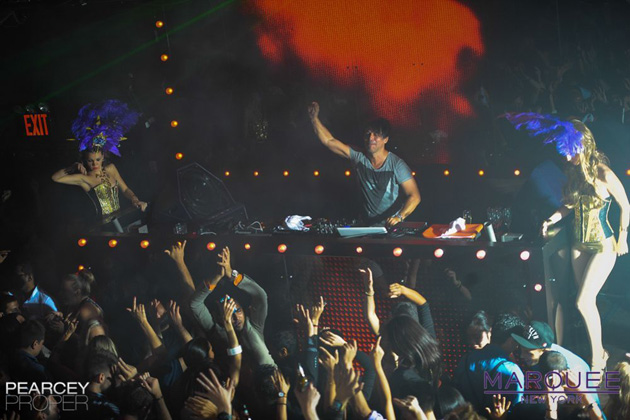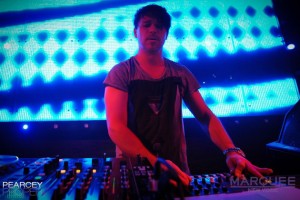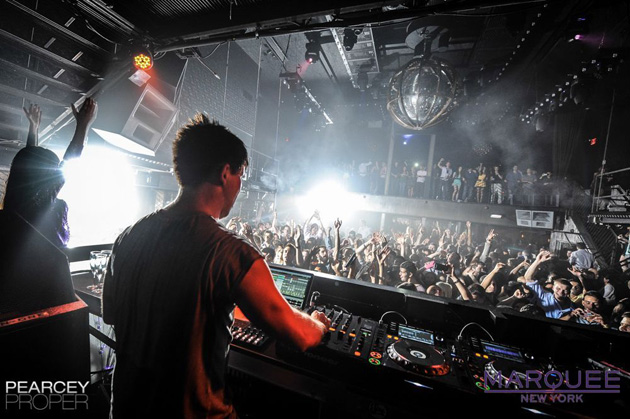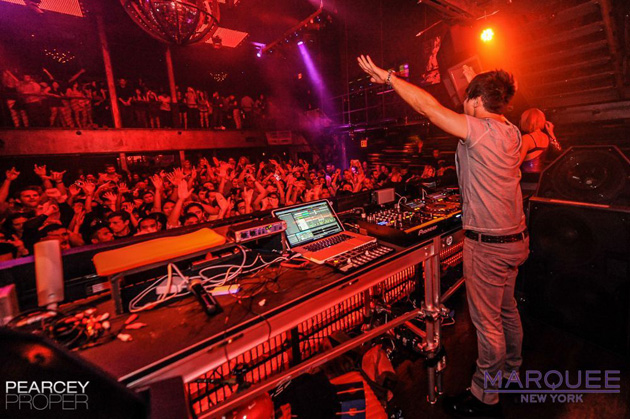 What’s the best way to do an album release party for a producer? Does it take the typical pop/rock/hip-hop format, involving the album’s music played in the background for listening? Or, does the producer DJ it as a set to show just how well it works in a club setting? With BT, the event introducing his ninth studio album A Song Across Wires to a crowd involved him behind the deck.
What’s the best way to do an album release party for a producer? Does it take the typical pop/rock/hip-hop format, involving the album’s music played in the background for listening? Or, does the producer DJ it as a set to show just how well it works in a club setting? With BT, the event introducing his ninth studio album A Song Across Wires to a crowd involved him behind the deck.
Yet, although the release dropped the day before, there’s a good change trance listeners – and fans of EDM in general – already know the hits (“Surrounded,” “Skylarking,” “Must Be The Love.”). The album release party, then, became not so much a matter of hearing entirely brand new material, but instead getting acquainted with the mixes of the new, stuff that hasn’t been heard before, and how it fits in with older tracks (like BT’s Tiesto collaboration “Love Comes Again”).
A few hours before BT stepped in the booth with a laptop and controller at Marquee New York, I stopped by the club for an interview with the producer. Although Pacha NYC and Cielo have been the go-to Manhattan venues for top-tier DJing talent, Marquee’s starting to rise up past its pop culture distinction as the place Justin Bieber went clubbing underage by attracting well-known producers like BT.

In one sense, BT’s answers served as a sort-of precursor to what audiences would hear a few hours later. In others, the set had a few surprises.
Even though he’s nine studio albums (plus soundtracks) into his career, BT had yet to make a truly “club” album until A Song Across Wires. “It was what was inspiring me at this moment,” he explained. “You know, stepping back to an album like This Binary Universe, what was inspiring me at the time was this idea of combining these jazz ideologies I studied at school and asymmetrical meter, and these things from jazz with things that I love about classical music, with things that I love about computer programming, so that was the thing that was deeply, passionately forming my work at the time.”
He went onto say, “This is the first time in my entire career I was inspired by club music culture – it really is. And, it’s funny because I participated in it for 20 years, but it’s the first time where I have heard my peer group and thought, ‘Wow, that is really interesting. Holy crap, what is that?’ Finding things that are authentically inspiring and exciting.”
 In line with the festival concept, a list of collaborators reads like a who’s who of trance: singer Nadia Ali, JES, TyDi, Arty, Tritonal, and others appear over the course of 12 tracks. “You know, all of them are friends or friends of friends, and so, I have a pretty strict policy of working with people who I enjoy as people first, and secondly, people whose work that I enjoy and do something different from what I do,” he explained. “There may be commonalities, but there’s difference, you know, and so, somebody like Tritonal I met playing at EDC, and said ‘I love what they’re doing and it’s different and kind of very big, loud, you know, but still very musical.’ And so, both of us said, ‘Wow, we gotta do some music together.’”
In line with the festival concept, a list of collaborators reads like a who’s who of trance: singer Nadia Ali, JES, TyDi, Arty, Tritonal, and others appear over the course of 12 tracks. “You know, all of them are friends or friends of friends, and so, I have a pretty strict policy of working with people who I enjoy as people first, and secondly, people whose work that I enjoy and do something different from what I do,” he explained. “There may be commonalities, but there’s difference, you know, and so, somebody like Tritonal I met playing at EDC, and said ‘I love what they’re doing and it’s different and kind of very big, loud, you know, but still very musical.’ And so, both of us said, ‘Wow, we gotta do some music together.’”
However, he went onto say, “Sometimes I found singers – Nadia
But while vocal trance opened his set later that evening, track selection and mixing exemplified the “right” way to do trouse – the sub-subgenre buzzword of the past two years. Expansive chord-based melodies emerged from heavy 4/4 beats, but in talking with BT about this trance-house-electro hybrid earlier that evening, he remarked, “It’s so funny – there’s always a name that’s an insult.”
In explaining this stance, he went onto say that “trouse” just replaces the contempt for actual trance from a decade ago: “Without naming names, big trance producers, friends of mine, ‘I don’t make trance; I make progressive house.’ And so, the idea that that’s the new insult – that’s ‘trouse’ – that’s the insult word, and so, personally, trance – like trance-trance, 1990s trance – is too fast for me. That’s the only thing I don’t particularly like about it – the speed of it – and not that I don’t like fast music – like, there are songs on this record that are 140 beats per minute – but the tempo, for dance music for me personally, between 128 and 132 feels very musical and, at the same time, like fast enough to have a good deal of energy. So, that sound that people talk about, I think a lot of that is coming from young producers that are coming up. And they never made trance; they’re making their first music, and so what they liked growing up was, they might like some trance records and they like Deadmau5. And anything that Deadmau5 has ever done [is] – I think Deadmau5 rolls over in his sleep at – 128 beats per minute.”

What stuck out was BT’s emphasis on making an album free of drops. In one sense, a move like that goes against the grain of modern EDM; these days, no matter if you record trance, house, or even a dubstep track, audiences expect a build – preferably, with chromatic pitch changes accompanying it – into a sharp dissipation that quickly changes direction and gets everyone’s hands in the air.
But the deal with drops seems to be that they’re great for a crowd, but from a listener’s perspective on record, they really don’t do much.
“Me personally, I think trance has evolved in such an amazing way, and I think it’s taking some time for listeners to adapt,” he said. “For example, ‘Skylarking,’ which is a track that everybody flipped out over, that, to me, was a track that I thought, ‘No one’s going to like this song.’ I’ve never said this out loud – I’ve said it to my family – but because there’s no big drop, there’s no big cannons that go off, it’s slow – it’s 127 beats per minute – but it’s this beautiful feeling, and so, I was so excited that people liked that.”
The trance fan, however, wanting the euphoric high courtesy of the 140-plus BPM range might have been slightly disappointed during BT’s set. Consistent four-to-the-floor beats kept his two hours in the booth grounded, although it picked up at points and experimented with dubstep beats alongside classic trance arpeggiated lines briefly.
On one hand, the set displays how well EDM works in two contexts. But orchestral-like melodic figures rising and falling over the course of two hours don’t always have to purely be fodder for a track to suddenly yell, “Drop the bass,” and the crowd to fist-pump in response. There’s substance, no matter if vocals appear in the mix or drop out for an instrumental focus. This approach – of actual music before showmanship – appears to have emerged when the tracks themselves were being created.

“More than usual of this record was done in the box as it were; a lot of things happened in the computer more than they typically do,” he explained when the interview shifted over to gear. “That being said, 50 or 60 percent of this record – 100 percent of this record – began with a piano or an acoustic guitar, so that’s what I write at. But there’s piles of analog synthesizers on this record, and I talk about gear a lot, and – without going completely odd the deep end – some of the things that were instrumental on this record were synths like Prophet 5, the Minimoog, my Oberheim SEMs. And, I also began to fall in love with the DAW FL Studio during the making of this record.”
As a tip to producers, he said, “And, kind of as a final thought to that, for those people reading this or listening that are producers, something I found during the course of making this record was incredibly inspiring was CDP, which stands for Composers’ Desktop Project. And, it’s a command-line language that runs the Mac OSX terminal you can do digital signal processing in, and for example, I did all of the vocal treatments on ‘Must Be The Love’ I did in CDP. So, there’s a lot of computer language stuff I used on this record, as well.”
Currently, BT is on the road with his A Song Across Wires tour in support of the album. If you can’t see him this time, you’ll be able to regularly hear him soon enough. Talking about his soundtrack projects toward the end of the interview, he mentioned, “I’m scoring a TV show – my first show – right now. I’m doing a show for ABC called ‘Betrayal,’ so I’m doing 13 episodes of this show. I’m really excited about it.”




